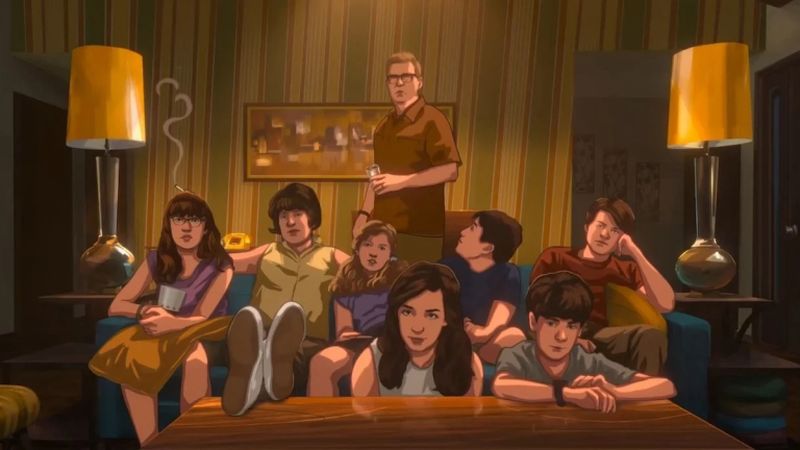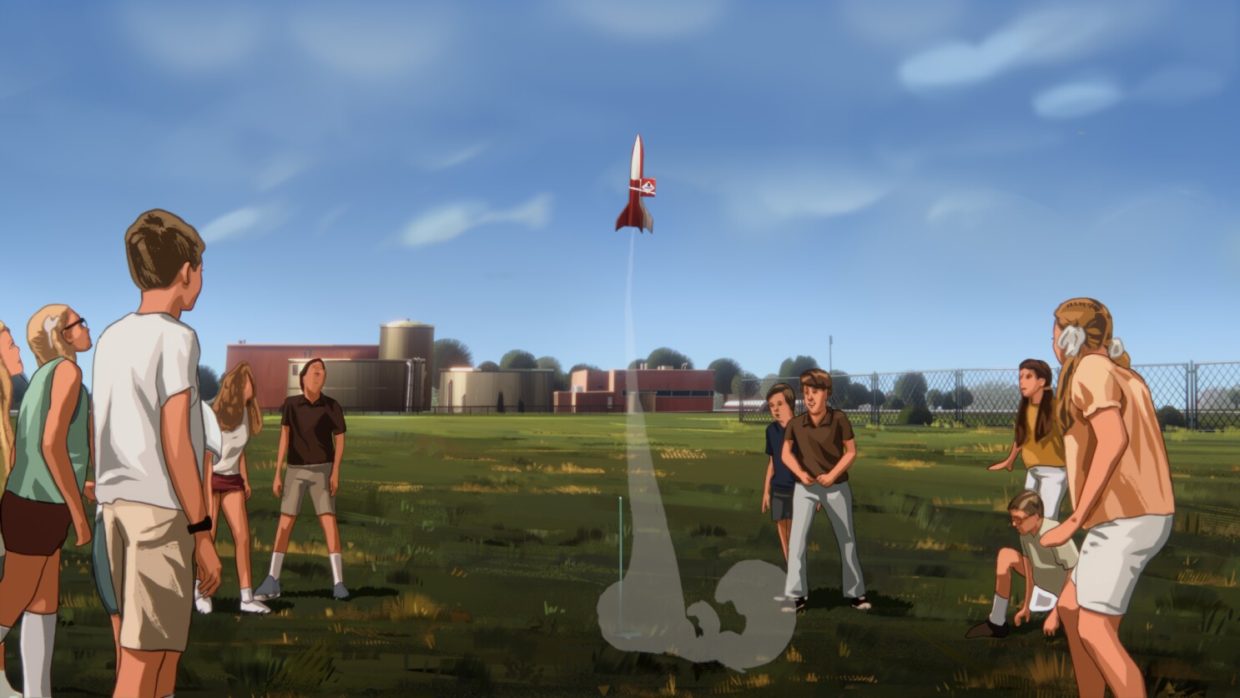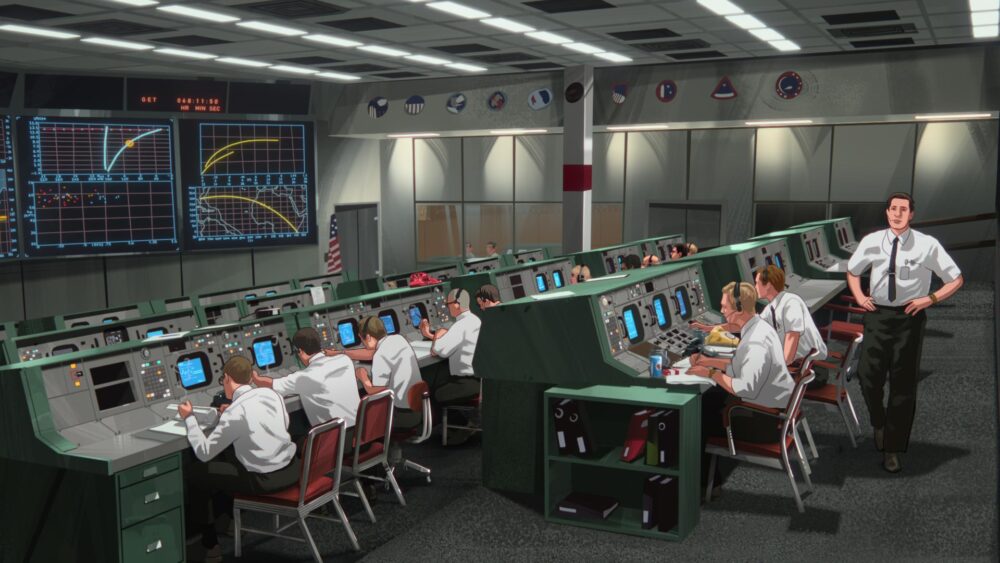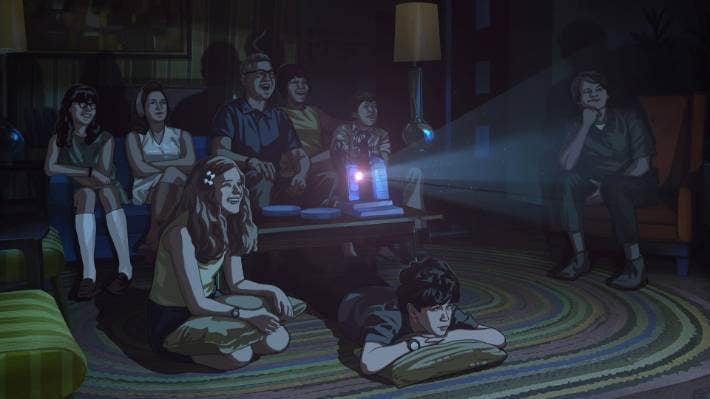For those not familiar with the term “rotoscoping,” it’s a device whereby footage is filmed and then painted over to give it the feel of animation – even though actors are giving the performances. It’s a truly captivating form when in the right hands, or even the wrong ones, but its labour intensiveness has prevented it from catching on in a bigger way. That hasn’t stopped its primary practitioner, Richard Linklater, from making his third feature-length rotoscoped film, after 2001’s Waking Life and 2006’s A Scanner Darkly.
It could be seen as a way of propping up sub-par material – as in A Scanner Darkly – but that’s not the case with Apollo 10 ½: A Space Age Childhood, the heavily autobiographical family-friendly trip down memory lane that has just landed on Netflix. To be certain, the technique enhances what Linklater is presenting us, but what he’s presenting us is already pretty wonderful – if not really structured as much of a narrative.
The film is Linklater’s note-perfect recreation of his Houston upbringing of the late 1960s, where the local industry was dominated by the space race leading up to humanity’s first moonwalk in July of 1969. However, the fundamentally realistic approach he has shown in almost all his films (A Scanner Darkly again being the exception) starts out with something decidedly fantastical. We open the film on the Linklater stand-in, named Stan and played by Milo Coy under all the rotoscoping, being recruited for his own moon mission, despite being about ten years old. (Linklater himself was about to turn nine during the moon landing, though Stan seems just a tad older than that.)
See, it turns out they built the lunar lander a bit too small. Instead of putting a chimpanzee in the cockpit, they opt for a human boy, so he can at least be the first human to walk on the moon. Stan of course agrees to the mission, which entails all the rigorous NASA training you would expect – including that familiar centrifugal simulator that goes around and around in a circle and causes everyone to vomit. Stan is no different, and we pause mid-hurl to set the stage.
So five minutes into the movie we get a 45-minute digression in which Linklater basically just dumps his memories on us. This section is effectively a succession of 30-second to two-minute vignettes that examine some familiar part of a late 1960s childhood in a booming Texas city experiencing a constant state of growth, where everything feels naïve and innocent, even with the Vietnam War and the related protests raging on the news. It’s not familiar to us because many of us have had that experience, but because Linklater lays the groundwork so effortlessly that it all feels instantly relatable. Story after story – narrated by Jack Black as the adult version of Stan – begins with the words “We used to …” or “I remember …”, and even though none of this is contributing to a story with much trajectory, it’s a generous accumulation of only good things.
What good things? The movies that were playing at the local cinema. The TV shows they used to watch. The snack products they eagerly consumed. The fast food restaurants they visited. The playground games they played. The improvised sports that boredom or rainy days prompted them to invent. The gruesome injuries caused by their childhood recklessness. Their interactions with school and community authority figures. A hippy-hating mother and a thrifty father who was a low-level part of the NASA machine. The humorous dynamics of a family with six children who were all trying to take the piss out of each other.
It’s hard to know how Linklater does this with such ease, but the perfect staging of these memories is a big part of it. Presumably, the actors needed to be doing their thing, but the backgrounds needn’t have always matched, since you can draw in a neighbourhood diner or a classic car much more easily than you can believably create a human with real human expressions and tics. You’ll find yourself wondering about the technique from time to time, but not out of distraction. The more dominant impression is of a world so perfectly captured, however they captured it, that you find yourself nostalgic for a 1960s Houston upbringing you never actually had.
The action does eventually return to Stan’s training to go to space, which starts to be interspersed with familiar news footage of the actual moonwalk, as Linklater experienced it himself. At least according to this film, Linklater and his family had free tickets that day to go to Astro World – an amusement park in the shadow of the new professional baseball stadium, the Astrodome – so they were all way too exhausted for this greatest moment in the history of human exploration, some falling asleep during it, all the others immediately departing for bed once they had curtly determined it was “over.” Stan himself actually sleeps through it, but according to his mum, memory is a funny thing, and years later all he’ll remember is watching every moment of it.
Memory is not only a funny thing in Linklater’s hands – this movie produces numerous laughs – but it’s also a glorious thing. It’s a rare sort of ineffable storytelling finesse that allows a person to translate his own memories and make them feel like the collective memories of the species. Even if you’re 40 years younger than the now 61-year-old Linklater, Apollo 10 ½ is the sort of film that will stimulate the memories of whatever you hold dear, in whatever era or part of the world they occurred.
Apollo 10 ½: A Space Age Childhood is currently streaming on Netflix.



